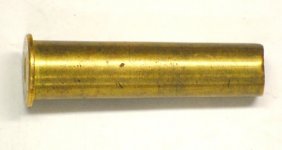magneticanomaly
Titanium
- Joined
- Mar 22, 2007
- Location
- On Elk Mountain, West Virginia, USA

 In a box of non-firearm-related junk, I found a strange cartridge case. Not sure if all of it is actually cartridge-case, or if it has an extraneous object jammed into it.
In a box of non-firearm-related junk, I found a strange cartridge case. Not sure if all of it is actually cartridge-case, or if it has an extraneous object jammed into it.Dimensions, rim diameter .598"
Body diam next to rim .490"
case mouth OD .447"
Overall length 1.968
(both last dims do NOT include the "teeth"
Headstamp "ST MK 15 MOD. 1
44 135 M"
Boxer primed, primer shows a small, slightly off-center hemispherical impression.
Can anyone tell me what it is?
Thanks!


